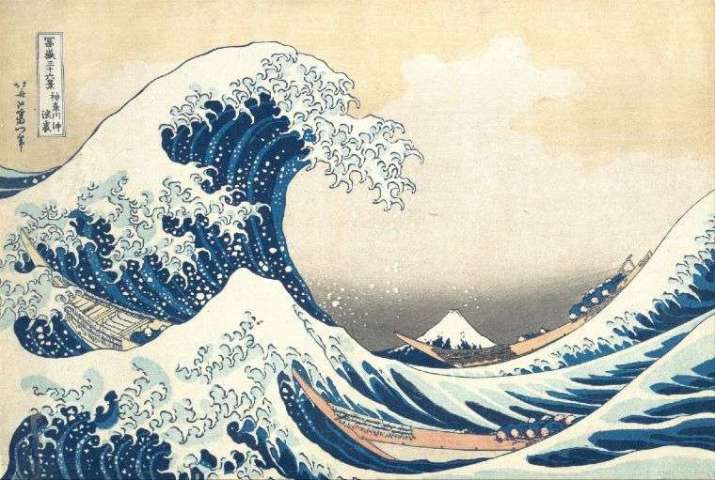
Katsushika Hokusai’s woodblock print The Great Wave off Kanagawa(1832) is one of the most iconic images in the world, as recognizable as most movie stars and more recognizable than any TikTok star. You can catch a random glimpse of the print almost anywhere: on t-shirts, tattoos, underwear, homepages . . . there’s even an emoji.
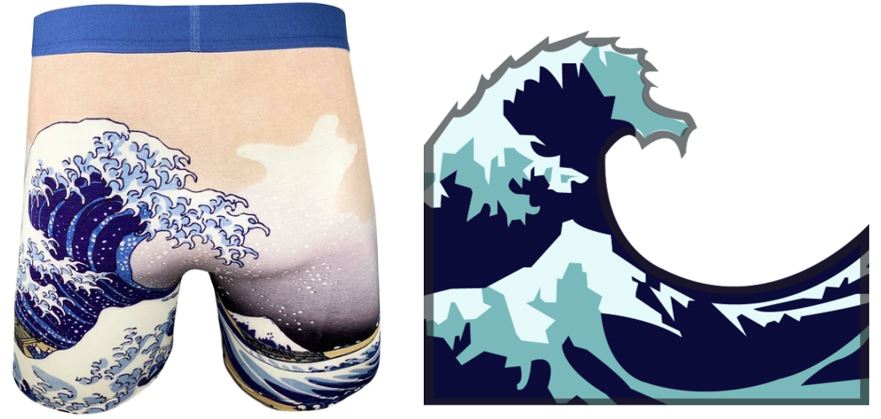
Since its creation, variations of Hokusai’s iconic print have been mobilized in response to a range of natural and human-made disasters: tsunamis, earthquakes, volcanic eruptions, hurricanes, aircraft crashes, and—yep—even the recent pandemic.* The historian Niall Ferguson recently used The Great Wave as the lead image for an article in The Boston Globe, arguing: “These days we are all a bit like those Japanese fishermen, cowering beneath a giant wave, the COVID-19 pandemic.”
Links like these are actually no big surprise given that Hokusai’s print depicts precisely the kind of literal and metaphorical waves that disasters often whip up. But what if another reason for the iconic print’s extraordinary popularity is that it also depicts a simple but compelling model of the human mind and points to an equally simple but compelling way of remaining calm in troubled times?
Consider the image for a moment. What do you notice? Where is your attention drawn?

There is of course the giant wave. Towering and immense, it dominates the picture with its menacing, claw-like fingers reaching down into the frothy center of the scene.
What might this “great wave” symbolize?

Literal waves perhaps, like the kind caused by tsunamis, earthquakes, hurricanes, or volcanic eruptions? And figurative waves too, like those of the pandemic, and the additional shock-waves of police brutality, systemic racism, domestic violence, and economic uncertainty the pandemic has heightened?
Sure, but what if this great wave also symbolizes the waves of emotion we sometimes experience when confronted with the sorts of unpredictable events that have been occurring outside us with such staggering frequency lately? In other words, what if the great wave is an external representation of the tsunami-sized emotions, thoughts, and sensations that occasionally swell up inside us when confronted with the waves outside of us? (The fact that Hokusai was himself a practitioner in the Nichiren school of Buddhism certainly lends some credence to this interpretation of the print.)
So if we take this approach to the print, what else can we notice?
Perhaps that beneath the menacing blue wave there are some long, precarious-looking yellow boats? Hunched over inside them, we can see blue-clad fishermen trying to stabilize their vulnerable vessels, hoping not to capsize. What might these boats represent?
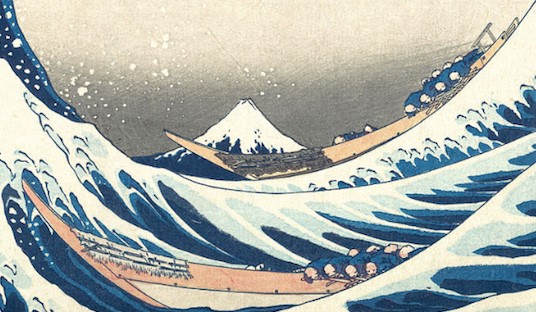
Perhaps the parts of us that are sometimes sucked into, swept up in, or carried away by the big waves that well up inside us? The egoic parts of us that rise and fall, and heave and buckle when they are caught up in, or over-identified with, the sturm und drang of our inner dramas?
But then, far off in the background, just below the center of the picture, we can also see the balanced, serene, snow-capped slopes of Mount Fuji. What aspect of ourselves might this majestic mountain represent?
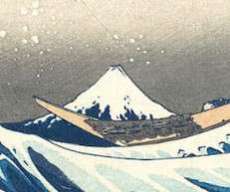
Solid and steady, stable and settled, perhaps it refers to that sense of self that can stand back like a curious observer and simply watch and witness as the great waves rise and fall within us? The grounded and durable, solid and reliable, witnessing perspective that can simply look on warmly from a quiet distance, watching serenely as the stormy seas within us swirl and swell, roil and break.
Okay sure, but how do we move from the treacherous wave inside us to this tranquil, mountain-like sense of self?
One of the many reliable routes is by means of the increasingly popular RAIN meditation, a practice initially developed by the Vipassana teacher Michele McDonald but refined and popularized by the renowned meditation teachers and clinical psychologists Jack Kornfield and Tara Brach.**
The letters of the acronym RAIN stand for the following four steps:
Recognize the feelings, sensations, images, and thoughts occurring inside you
Allow them to be just as they are and drop any resistance to them
Investigate them with warm, non-intellectual, non-identified curiosity
Nurture the difficult feelings and sensations inside you with self-compassion
With practice, this simple meditation can shift us, over and over again, out of our inner turmoil to a steady, mountain-like vantage point from which we can not only watch the great waves inside us, but calm and soothe them.
But there is another small detail in Hokusai’s print that may offer us a helpful reminder as we practice in this or in other ways. Did you notice the small, mountain-like wave in the left foreground of the print?
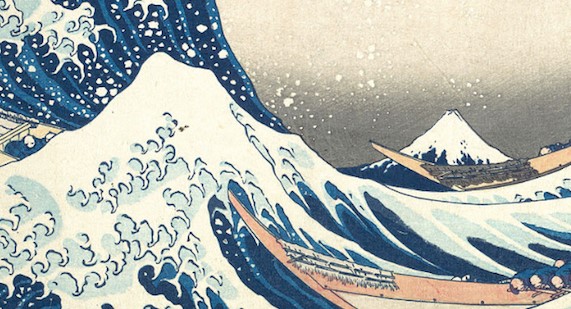
Snow-capped, with a blue base, and shaped like a mountain, it is similar in many ways to the mountain in the background. Yet whereas Mount Fuji is firmly rooted in the Earth, comprised of solid stone and located at a healthy distance from the great wave, this watery, mountain-like wave has formed for an instant out of choppy, talon-shaped seawater, will keep its mountainous shape for only a fleeting moment, and is right up-close to the treacherous wave.
Shifting and unstable, perhaps it represents the shaky and fleeting mental states, rather than enduring and stable mountain-like traits, that we often experience while practicing. As Rick Hanson and many other neuropsychologists point out, most mental/neural activity flows through the brain without leaving any lasting effect. Like Hokusai’s watery, mountain-like wave, they are here one second and gone the next. But intense, prolonged, or repeated mental/neural activity—especially if it is deliberate—leaves an enduring imprint in our neural structure, like Hokusai’s Mount Fuji. As the popular saying in neuroscience goes: “Neurons that fire together, wire together.” Or as Hanson puts it: “Mental states become neural traits.”
As we practice firming up the watery, mountain-like waves of our mental states into unshakeable Mount Fuji-like mental traits, Hokusai’s print may offer us at least one more reassuring reminder.
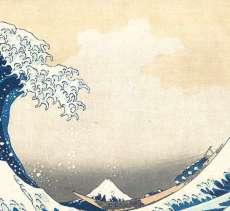
If we look closely, we can see that a solid bank of light grey and beige clouds have only recently begun to lift like a curtain to reveal (or re-reveal) the mountain. What might this little detail suggest?
Perhaps that the mountain-like observing self has only recently re-emerged after having been temporarily obscured in the storm, just as we all, when triggered or agitated, lose our ability to watch our internal states with warm, alert awareness? It’s not like the mountain disappeared altogether—how could it?—but perhaps these rising clouds offer us a gentle reminder that our access to the spacious vantage-point from which we can view our inner experiences in this way is inevitably obscured at times, only to re-emerge when the storm clouds lift.
Even so, because they have the power to transport us, even temporarily, from the roiling waves to the remote mountaintops inside us, we may be concerned that practices like these run the risk of sapping the mobilizing energy of our indignation, redirecting it away from movements of social transformation and replacing it with a detached or disengaged contemplative apathy?
Not so. In fact, most engaged meditation teachers are of the opinion that such practices are indispensible in creating sustainable, healthy, and effective ongoing movements of social transformation. To take just one example, in her recent book Integrating Mindfulness Into Anti-Oppression Pedagogy (Routledge 2015), Beth Berila reminds us: “A critical mindfulness skill for unlearning internalized oppression is the cultivation of the witness, which means the ability to observe what is happening. Rather than drowning in our experiences, the witness lets us be bigger than our emotions.” (80)
Indeed, like many teachers of engaged mindfulness, Berila places the practice of “cultivating the witness” at the very heart of sustainable and ongoing efforts at redressing injustices of all kinds. In fact, in a variant of the RAIN meditation, Berila places Hokusai’s mountain-like witnessing position at the very centre of her core practice, which she sums up in the following acronym:
Be: breathe and just be
Embody: feel what is happening inside
Aware: notice what you feel
Witness: go beyond feelings and observe
Accept: do not judge what you feel
Reflect: consider possible responses
Engage: decide how to respond and act
In this way, we can move from the treacherous waves to the serene mountaintop and then, with awareness, back to the waves. Not the waves of the past, but instead the transformative waves of the future.
*After the horrific 2011 earthquake and tsunami in Tōhoku, Japan, images of the The Great Wave started popping up everywhere, from relief fundraising appeals to the work of Japanese artists who adapted it to comment on the disaster. The artist David Salle also incorporated The Great Wave into a pictorial cycle that comments on Hurricane Katrina. There is a memorial in Stoney Point Beach, Long Island, to the victims of Pan Am Flight 800—which crashed over Long Island in 1996—featuring an image of Hokusai’s wave morphing into birds flying skyward. Much earlier, in 1948, the novelist Pearl Buck wrote an allegorical children’s story called The Big Wave that was illustrated with Hokusai’s print. The book was intended to help kids deal with the aftermath of WWII and the beginning of the Atomic Age.
** For a book-length guide to the many applications and variations of this practice, see Tara Brach’s Radical Compassion: Learning to Love Yourself and Your World with the Practice of RAIN.













